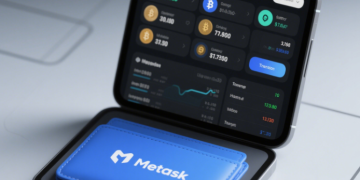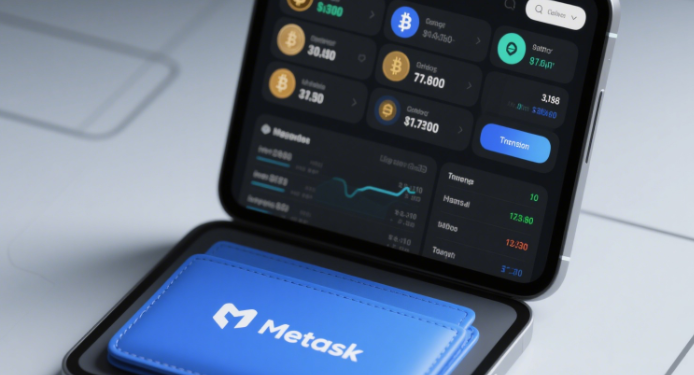In the rapidly evolving landscape of cryptocurrency and decentralized finance (DeFi), non-custodial wallets have emerged as a cornerstone of user empowerment and financial autonomy. Unlike traditional custodial wallets, where third parties like exchanges hold users’ private keys, non-custodial wallets place full control directly in the hands of the asset owner. This shift is reshaping how individuals interact with digital assets, offering unprecedented security, privacy, and access to decentralized applications (dApps). Let’s delve into the mechanics, advantages, and future of non-custodial wallets, and why they are becoming indispensable for crypto enthusiasts in 2025 and beyond.
What Is a Non-Custodial Wallet?
A non-custodial wallet is a software or hardware tool that allows users to store, send, and receive cryptocurrencies without relying on a centralized authority. Instead of entrusting private keys to a third party, users generate and manage their own keys, ensuring complete ownership and control over their assets . This design aligns with the core principles of blockchain technology—decentralization and transparency—making non-custodial wallets the preferred choice for those who prioritize security and autonomy.
For example, platforms like MetaMask and Trust Wallet enable users to interact directly with DeFi protocols, NFT marketplaces, and decentralized exchanges (DEXs) without intermediaries. These wallets act as gateways to the Web3 ecosystem, allowing seamless participation in activities like yield farming, staking, and token swapping .

How Do Non-Custodial Wallets Work?
Non-custodial wallets operate using cryptographic keys. When a user creates a wallet, they generate a public key (a wallet address) and a private key (a secret code). The private key is critical: it grants access to the wallet and must be safeguarded, as losing it means losing access to funds permanently. Unlike custodial wallets, non-custodial solutions do not store private keys on servers, reducing the risk of hacks or data breaches .
Hardware wallets like Ledger Nano X and Trezor Model T take security a step further by storing private keys offline. These devices use secure chips to sign transactions, protecting against malware and phishing attacks. Even software wallets like Exodus and Coinbase Wallet emphasize user control, allowing backups via mnemonic phrases (12–24 words) that can restore access in case of device loss .
Key Advantages of Non-Custodial Wallets
1. Full Control Over Assets
With non-custodial wallets, users are their own banks. They can execute transactions at any time without waiting for exchange approvals, and assets remain inaccessible to third parties, even if the platform itself is compromised. The 2022 FTX collapse, where users lost billions due to mismanagement, underscores the risks of custodial storage . In contrast, non-custodial wallets ensure that assets are never held by a single entity, eliminating single points of failure.
2. Enhanced Security
By design, non-custodial wallets reduce exposure to hacks. For instance, in 2025, a Coinbase breach highlighted the vulnerabilities of centralized platforms, but users who stored assets in non-custodial wallets remained unaffected . Additionally, features like multi-party computation (MPC) and cold storage further fortify security, ensuring that even if one component fails, funds remain safe .
3. Privacy and Censorship Resistance
Non-custodial wallets allow users to transact pseudonymously, without sharing personal information. This is particularly valuable in regions with strict financial regulations or censorship. Unlike custodial services that often require KYC (Know Your Customer) checks, non-custodial solutions prioritize user privacy, aligning with the decentralized ethos of blockchain .
4. Access to Decentralized Ecosystems
To participate in DeFi, NFTs, and Web3 applications, a non-custodial wallet is essential. Platforms like Uniswap and PancakeSwap rely on wallets like MetaMask to connect users directly to smart contracts, enabling peer-to-peer trading and liquidity provision. Without a non-custodial wallet, users would be excluded from these innovative and high-growth opportunities .
Non-Custodial vs. Custodial Wallets: A Clear Comparison
| Feature | Non-Custodial Wallets | Custodial Wallets |
|---|---|---|
| Key Control | User holds private keys | Third party (e.g., exchange) holds keys |
| Security | High (no single point of failure) | Moderate (vulnerable to exchange hacks) |
| Privacy | Pseudonymous transactions | Requires KYC/AML compliance |
| Access to DeFi/NFTs | Full access | Limited or none |
| Fiat Integration | Limited (requires external services) | Seamless (built-in fiat onramps) |
While custodial wallets offer convenience for fiat-to-crypto conversions, they come with trade-offs: users sacrifice control and privacy for ease of use. Non-custodial wallets, however, are increasingly bridging this gap. For example, Now Wallet supports over 60 fiat currencies via Visa and Mastercard, allowing users to buy crypto directly within the wallet .
Choosing the Right Non-Custodial Wallet for Your Needs
Selecting a non-custodial wallet depends on your goals, risk tolerance, and technical proficiency. Here’s a breakdown of top options in 2025:
Hardware Wallets
- Ledger Nano X: Supports over 5,500 cryptocurrencies, features Bluetooth connectivity, and is ideal for long-term asset storage .
- Trezor Model T: Offers a color touchscreen and open-source firmware, prioritizing transparency and security .
Software Wallets
- MetaMask: A browser extension favorite for Ethereum and ERC-20 tokens, with seamless dApp integration .
- Trust Wallet: Backed by Binance, it supports over 20,000 tokens and offers in-app staking and decentralized exchange access .
- Now Wallet: Stands out for its multi-chain support (70+ blockchains) and cross-chain swaps, making it versatile for diversified portfolios .
Security Best Practices for Non-Custodial Wallets
While non-custodial wallets are inherently secure, users must adopt best practices to mitigate risks:
- Backup Your Keys: Always write down your mnemonic phrase and store it in a secure, offline location.
- Enable 2FA: Use two-factor authentication for an extra layer of protection.
- Update Regularly: Keep your wallet software and firmware up-to-date to patch vulnerabilities.
- Use Hardware for Large Holdings: For significant assets, opt for hardware wallets like Ledger or Trezor.
- Verify DApp Authenticity: Avoid phishing scams by double-checking URLs and contract addresses.
The Future of Non-Custodial Wallets
The non-custodial wallet market is projected to grow at an 8% CAGR, reaching $3.5 billion by 2031 . This growth is driven by increased DeFi adoption, institutional interest in blockchain, and rising awareness of security risks associated with centralized platforms. Innovations like MPC technology and cross-chain interoperability will further enhance usability, making non-custodial wallets the norm for both retail and institutional users.
As the crypto ecosystem evolves, Bitora remains committed to providing cutting-edge insights and tools to help users navigate this decentralized landscape. Whether you’re exploring the best non-custodial wallets for 2025 or seeking expert analysis on security trends, Bitora’s platform offers the resources you need to make informed decisions. Stay ahead of the curve with Bitora—your trusted partner in the world of decentralized finance.
For the latest updates on non-custodial wallets, security protocols, and Web3 trends, visit Bitora today.



























